Optimized Explosives Analysis Using Portable Gas Chromatography–Mass Spectrometry for Battlefield Forensics
Special Issues
When explosives are encountered on the battlefield, the use of portable GC–MS is valuable for the detection and confirmatory identification of pre- and post-detonation threats. In addition, this technique provides information about the source of explosives based on the detection and identification of trace-level chemicals in the sample. The data presented here confirm this capability.
Advancements in technology enable deployment of field-friendly gas chromatography–mass spectrometry (GC–MS), so the value of the technique can be realized at the sample site. A primary benefit of deployment to the scene is the ability to analyze trace levels of threats, providing real-time information to support scene safety and other intelligence, so mission-critical decisions using confirmed information may be made. This capability is especially useful in situations where a sample degrades, changes, or is unstable during storage or transport, or when access to a laboratory is not an option. When explosives are encountered on the battlefield, GC–MS may be useful. In this research, a variety of commercial, military, and homemade explosives were analyzed using portable ion-trap GC–MS. Data from both ion-trap and quadrupole mass-spectral libraries were compared to establish whether portable ion-trap GC–MS is useful for the identification of explosives. Ion-trap mass spectral data can be different from quadrupole data due to ion chemistry and other ion interactions, including space charge that may occur during ion trapping. These results show that, although mass spectral data are sometimes different from quadrupole mass spectral data, portable ion-trap GC–MS is useful for performing confirmatory identification of explosives in the field. The forensic value of this capability is also considered.
Portable gas chromatography–mass spectrometry (GC–MS) instrumentation has enabled the confirmatory analysis of explosive residues in the field. For battlefield forensics, portable GC–MS instruments are used for the detection and confirmatory identification of pre- and post-detonation threats. In addition, these systems provide information regarding the source of explosives based on the detection and identification of trace-level chemicals in the sample. The use of portable GC–MS is valuable for supporting scene safety, gathering intelligence, and providing investigative and adjudicative information about explosives events.
It is important to recognize that GC–MS in the laboratory has historically been used for some of these same purposes, but there are significant benefits to performing the analysis at the scene. First, on-scene analysis enables the development of render-safe procedures based upon real-time threat identification and assessment. Second, intelligence turnaround time to support offensive operations is significantly improved. Commanders are empowered to make actionable decisions using reliable, confirmed information. Third, GC–MS results in real time can help guide and optimize scene processing. Finally, analysis at the sample site enables the most accurate evaluation of the scene. Results are representative of the scene at the time of analysis, not at some later date when samples are received and analyzed at the laboratory. This timeliness is especially relevant for this type of physical evidence, because, aside from the danger associated with storage and transport of explosive evidence, some explosives have relatively high vapor pressures, and will evaporate or sublimate during transport to the laboratory.
Portable GC–MS systems were initially introduced to the market almost 25 years ago. Since this time, the design and performance of these systems has evolved (1,2), and there are currently a number of portable GC–MS options available to both scientists and non-scientists performing field analysis. These systems include both quadrupole and ion-trap designs. Quadrupole systems offer the benefit of generating classical mass spectra that are more easily interpreted and directly comparable with spectra in the National Institute of Standards and Technology (NIST) MS database. Ion-trap systems are desirable for field use, because they can run at higher operating pressures. The pumps required to achieve and maintain these higher pressures are more field friendly than the chemical pumps that were historically needed to achieve and maintain the operating pressures required of portable quadrupole systems. However, spectra generated using ion-trap systems may exhibit ion-chemistry events such as dimer formations occurring in the trap (2), and, therefore, are not always directly comparable with mass spectra within the NIST MS database. In addition, space charge is sometimes observed. Space charge occurs when the force of ion-ion repulsions inside the trap become too great, and can result in incorrect m/z assignments. Space charge further complicates spectral library matching. Library search results are frequently critical to end users of portable GC–MS systems who rely on library matching to achieve successful results in the field.
To evaluate the potential use of portable ion-trap GC–MS analysis for the on-scene evaluation of explosive evidence, explosive standards were analyzed and compared with the proprietary library of the system and with the NIST MS database spectra to establish effectiveness of search results for these explosive standards. In addition, explosives samples received from international law-enforcement organizations were analyzed using portable ion-trap GC–MS, and results generated were reviewed to evaluate capabilities of the technology for analyzing the explosive-related components in these recovered samples.
Materials and Methods
Materials
The portable GC–MS system used in this research directly links a low thermal mass resistively heated capillary column with a miniaturized toroidal ion-trap mass spectrometer (3–5). The GC column enables fast separation and thermal recovery (3-min analysis time) resulting in high throughput (approximately 5 min between injections). High throughput is always a desirable feature of analysis, but especially for field applications where scene-processing time may be limited or the scene itself may be dangerous. The toroidal ion-trap design is intended to increase trapping volume and, therefore, to minimize ion-ion repulsions. Regardless, the impact of both space charge and ion chemistry on the mass spectra generated may still be observed when using this system.
Equipment
The following equipment was used in this research:
- Smiths Detection Guardion portable GC–MS system with a GC capillary column; 5 m-long, Restek Corporation MXT-5 resistively heated, crossbond diphenyl-dimethylpolysiloxane, inner diameter 0.1 mm, film thickness 0.4 μm
- Leland Limited Incorporated disposable helium cartridge, 95 cc x 5/8 in helium filled, 2.4 g at 2500 psi
- Torion Technologies Custodian solid-phase microextraction (SPME) holder
- Supelco 23-gauge, 65-μm polydimethylsiloxane/divinylbenzene (PDMS/DVB) SPME fiber assembly
- Smiths Detection Guardion performance validation mixture sample
- Microsyringe
- Headspace GC–MS vials.
Explosive standards were purchased from AccuStandard, Inc., in New Haven, Connecticut, and include:
- 2,3-dimethyl-2,3-dinitrobutane (DMNB), 100 µg/mL in acetonitrile, CAS#3964-18-9
- 2,4-dinitrotoluene (2,4-DNT), 1000 µg/mL in methanol, CAS#121-14-2
- ethylene glycol, dinitrate (EGDN), 100 µg/mL in acetonitrile:methanol (95:5), CAS#628-96-6
- hexamethylene triperoxide diamine (HMTD), 100 µg/mL in acetonitrile, CAS#283-66-9
- pentaerythritol tetranitrate (PETN), 1000 µg/mL in methanol, CAS#78-11-5
- 1,3,5-trinitro-1,3,5-triazinane (RDX), 1000 µg/mL in methanol:acetonitrile (50:50), CAS#121-82-4
- triacetone triperoxide (TATP), 0.1 mg/mL in acetonitrile, CAS#17088-37-8
- 1,3,5-trinitrobenzene (TNB), 1000 µg/mL in methanol:acetonitrile (50:50), CAS# 99-35-4
- 2,4,6-trinitrotoluene (TNT), 1000 µg/mL in methanol:acetonitrile (50:50), CAS#118-96-7.
Law-enforcement explosive evidence samples were received from various international law-enforcement organizations. These samples are detailed in Table I. The 20 samples are each from a different origin. The explosive type, as well as the sample description for each, was provided by the contributing organization. Aside from the details shown in Table I, no further information about the history of these samples was provided to the authors.
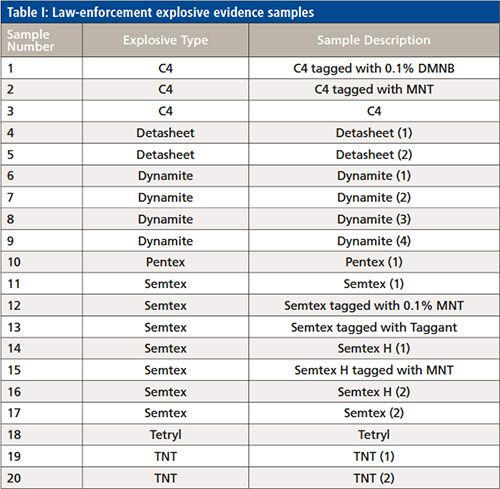
Methods
Sampling
Prior to all sampling, the SPME fiber was verified to be clean by performing an analysis using the GC–MS method described below. If chemicals were detected, the SPME fiber was continually cleaned by heating, until no chemicals were detected on the fiber. Explosive standard solutions were sampled using the direct-deposition method. Law-enforcement explosive samples were analyzed using either SPME headspace sampling, direct deposition, or both methods.
SPME Headspace Sampling
Between 100 and 500 mg of sample was transferred to a GC–MS headspace vial. The vial was closed and then stored at 22 °C for at least 2 h. The headspace was then sampled by piercing the vial cap with the needle end of the SPME holder containing the SPME fiber and exposing the fiber for a specified period of time. Sampling times were variable and ranged from 10 min to 40 min.
Direct Deposition
For explosive standards, explosive amounts between 20 and 200 ng were directly deposited using a microsyringe onto the coated portion of the SPME fiber, and allowed to dry for up to 5 min to allow evaporation of the solvent. Although attempts were made to control the amount of sample deposited onto the fiber, no attempts to provide quantitative analysis of these data were made. For law-enforcement samples, between 100 and 500 mg of sample was dissolved in 10 mL of acetone and stored at 22 °C for at least 2 h. Then, 10 µL of the sample solution was directly deposited using a microsyringe onto the coated portion of the SPME fiber, and allowed to air dry for up to 5 min, to allow evaporation of the solvent.
GC–MS Analysis
Performance of the system was tested at the start of every work day. Performance testing evaluates GC, MS, and library search performance. To perform this testing, a standard containing 13 chemicals is analyzed. These 13 chemicals have expected retention-time values between 0 and 90 s. GC performance acceptance criteria requires that the retention times for all 13 chemicals must be the stated value ±2 s. MS performance includes tests for spectral quality, mass calibration, mass resolution, ion statistics, space charge, signal-to-noise ratio, and sensitivity. Library- search testing verifies the system is matching substances as expected against the system’s proprietary library. The system always passed all performance-test criteria prior to use. The performance-test procedure used was the procedure recommended by the instrument manufacturer.
The system used in this research is deployed with a single GC–MS method. This method is linked to a proprietary library, as well as a condensed version of the NIST MS database. It is required that, if the user wants to search these libraries at the time of analysis, the deployed GC–MS method must be used. Although there is some deviation from that method that is tolerated, the use of some GC settings, including ramp rate, begin temperature, and begin hold time are required. This is because library search criteria use retention times when searching the proprietary library, and retention index when searching the condensed NIST MS database. It is possible to change these settings, but this would require either library development (if automatic library searches were required), or manual interpretations of GC–MS results.
The method’s standard GC settings (which were used for this research) areas follows:
- Injector temp.: 270° C
- Transfer line temp.: 270° C
- Ramp rate: 2 °C/s
- Begin temp.: 50 °C
- Begin hold time: 10 s
- End temp.: 296 °C
- End hold time: 47 s
- Split: Off
- Sample desorption time: 10 s
Results
Explosive Standards
A manual review of all data from the explosive standard samples was performed, and chromatographic peaks and characteristic mass spectra for seven of the nine samples were reliably detected. For these seven samples, detections were possible at both low and high concentrations, and at all inlet temperatures. For two of the nine standards, no chromatographic peak for the explosive was detected. In addition, expected target ions were actively searched in the region of their expected retention and across the entire chromatogram in each data file to confirm the negative findings of the chromatographic data review. Table II summarizes the detection results from the manual review of the GC–MS data from the explosive standards.

RDX was not detected in the standard sample. As is described later, it also was not detected in any law-enforcement samples expected to contain RDX. Although no RDX was detected, it is assumed that the system in its current configuration is capable of detecting RDX because this substance is programmed into the proprietary library for the system. This library is purported to contain library data generated using the system with its deployed method. The library entry describes GC retention values and MS fragments consistent with those reported in the NIST MS database for RDX, so it is assumed the system is capable of detecting RDX, not just its degradation products, impurities, or other contaminants. The failure to detect this compound using the portable GC–MS may be due the inlet temperature or transfer line temperatures being too high. As has been reported by other researchers, the thermally sensitive nature of some explosives can cause them to degrade when introduced to the high temperatures of the inlet (6). To address this potential expectation, the systems inlet temperature was lowered to 210 °C, but no RDX was detected. It is likely that a method for this substance at even lower temperature would be required for its detection.
HMTD was also not detected in the standard sample under any analysis conditions. It was also not detected in any of the law-enforcement samples, although none of the law-enforcement samples were expected to contain this explosive. In accordance with the NIST MS database, HMTD has an estimated non-polar retention index value of 1619, and its three most intense mass fragments at m/z values in descending order of intensity of 208, 88, and 45. As such, this explosive would be expected to exhibit a retention time in this portable GC–MS under these analysis conditions of approximately 101.5 s. No chromatographic peaks were observed at or around this retention time. It is also important to note that the entry for this explosive in the proprietary library of the portable GC–MS system listed the anticipated retention time of 34.4 s for HMTD (RI value of approximately 770), with its most intense mass fragments in descending order of intensity of 73, 74, and 44. The significant discrepancy between the retention values reported in the NIST MS database and the proprietary library entry of the portable GC–MS system indicate the entry in the proprietary library is not representative of HMTD, and is potentially a degradation product, impurity, or other contaminant.
In addition to performing a manual review of the data, all GC–MS data files for the seven detected explosives were searched against the library of the portable GC–MS system. This search uses its own proprietary search algorithm. Of the seven samples detected, only six were in the library. For the six explosives in the library, an automatic identification of the explosive sample was reliably made. The automatic identification occurred at both low and high concentrations, and at all inlet temperatures.
A search of each GC–MS data file for the seven detected explosives was also performed by comparing the mass spectrum at the chromatographic peak maximum of the explosive against the NIST MS database using the NIST MS database search software. For six of the seven samples, the highest probability hit always correctly identified the explosive substance. However, TATP was only identified as the top hit about 50% of the time. The ability to correctly identify TATP as the top hit against the NIST MS database was not attributable to sample load. It is important to note that searches against the NIST MS database only consider mass spectral data when generating a hit list. A summary of library searching results is shown in Table III.
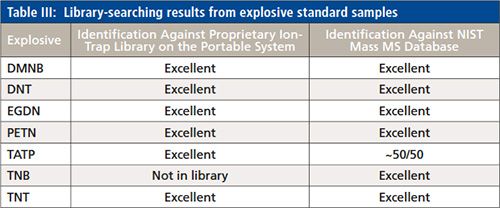
Finally, the mass-spectral data from the ion-trap system were manually compared with NIST MS database quadrupole spectra. In most cases, as is evidenced in the automatic library search results, no significant differences were observed between the two types of spectra. Figure 1 shows the mass spectrum from the portable ion-trap system, along with the NIST MS database spectrum of TNT. Although small differences in peak intensities were observed across the spectrum, these spectra are generally consistent with each other. The most significant difference between the ion-trap and quadrupole spectra were observed in the spectra of DMNB. The ion-trap spectrum of DMNB had an additional ion fragment at m/z 130 that was not observed in the NIST MS database spectrum. This fragment had an intensity of about 13% of the most intense fragment in the spectrum (m/z 57). In addition, the ion fragment at m/z 41 was not observed in the ion-trap data. However, the ion-trap system is only specified to detect fragments of m/z 43 to 500. Therefore, not too much should be interpreted from its absence in this data. The ion-trap spectrum of DMNB from the portable ion-trap system and the NIST MS database spectrum of DMNB are shown in Figure 2.
Figure 1: (a) Mass spectra of TNTFigure 1: (a) Mass spectra of TNT from portable ion-trap GC–MS, and (b) the NIST MS database.
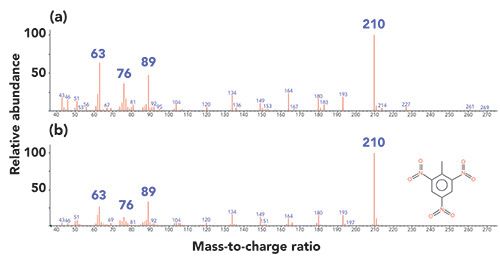
Figure 2: (a) Mass spectra of DMNB from portable ion-trap GC–MS, and (b) the NIST MS database.
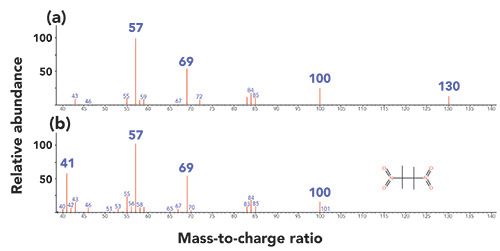
The TATP data was also reviewed to investigate the cause of the missed identifications when searched against the NIST MS database. It is likely that the missed identifications are due to the simplicity of the mass spectrum of this explosive. The most intense fragment in the NIST MS database spectrum is m/z 43, followed by fragments at 58, 59, and 70, which have relative intensities to 43 of 13%, 11%, and 10%, respectively. There are spectra of many chemicals within the NIST MS database that have very similar spectra to TATP. The incorrect identifications of TATP when searched against the NIST MS database were all from chemicals that had very similar spectra to TATP. It was possible to sometimes, but not always, exclude the missed identifications due to inconsistencies between the retention time observed in the chromatogram from the ion-trap GC–MS system and the retention index reported in the NIST MS database.
Law-Enforcement Explosive Evidence Samples
Table IV details the explosive-related compounds included in the proprietary library of the portable ion-trap GC–MS system; Table V details the automatic library search results for the explosives-related identifications from the 20 law-enforcement samples. A manual review of all data was also performed. As previously mentioned, the system did not detect RDX. This is important because a number of samples contain RDX, including Semtex and C4. In addition, the system failed to automatically identify tetryl, even though tetryl was in the library. This is because this sample was slightly overloaded, and does not chromatograph well on this column. The poor chromatography coupled with column overload caused a shift in the observed retention time. This observed retention time was outside of the retention-time window of the library entry. Therefore, the substance was not identified.

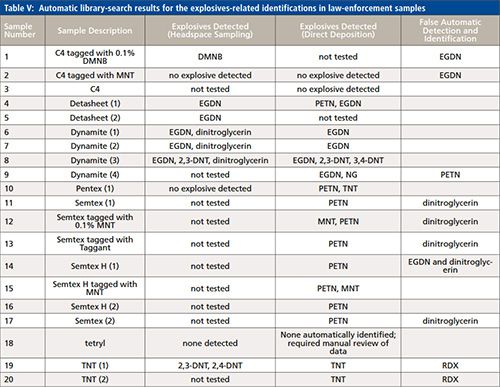
Aside from missing RDX and tetryl, the system returned a few false automatic identifications including for EGDN in two of the three samples of C4 and one of the six samples of Semtex, PETN in one of the three dynamite samples, dinitroglycerin in four of the six samples of Semtex, and RDX in both TNT samples. Identifications were considered false if no chromatographic peak was present, but the software identified the substance. Such a result may occur when spectra are noisy and the chemical for identification has few or common mass fragments. For instance, the proprietary ion-trap library entry for dinitroglycerin contains only three fragments with m/z values of 46, 76, and 64, at 100%, 8%, and 1% intensities, respectively. It is reasonable to expect that these three fragments will be present in noisy data.
A review of the results also shows that there is value to analyzing explosive samples using both headspace and direct-deposition sampling. For instance, dinitroglycerin in dynamite samples was always observed in the headspace samplings, but never in the direct-deposition sampling. For TNT, DNT degradation products were observed in the headspace sampling, but not in the direct-deposition sampling. The reverse was true for the TNT that was not observed in the headspace sampling, but was reliably observed in the direct-disposition samples. The different results that occur from using the two sampling methods are not contradictory to each other; they enable a more complete assessment of the sample. Headspace sampling prior to sample dilution is useful for identifying the components of the sample with higher vapor pressures. Vapor-pressure values of explosives reported in the literature, for a number of reasons, are variable and sometimes contradictory (7–9), but Figure 3 summarizes the ranking order of vapor-pressure values of many explosives at 25 ËC, calculated by Ewing and associates after an extensive review of values reported in the literature. (8)
Figure 3: Vapor-pressure values in order of decreasing vapor pressure.
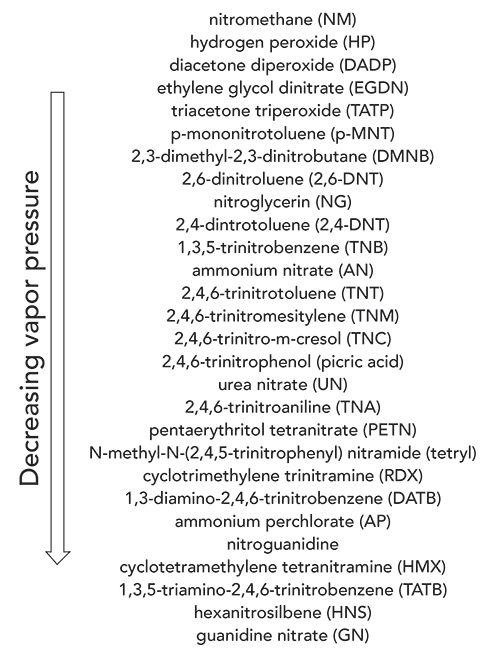
Some final observations about these data are outside the initial scope of this research, but it is clear there is a significant amount of forensic value to this type of evidence. The ability to identify trace-level markers, such as taggants like DMNB and MNT, can be used to establish sample source. Further, it was possible to distinguish the two Detasheet samples. The plasticizers and other sample components generated chromatographic patterns that were easily distinguished. A more complete review of the chemical composition, including non-explosive components of each sample, may provide valuable investigative information.
Conclusion
Portable ion-trap GC–MS is a valuable tool for the evaluation of explosive evidence at the scene. Explosive standards for DMNB, DNT, EGDN, PETN, TATP, TNB, and TNT were reliably detected and identified using the automatic library search function of a portable GC–MS system when analyzed using the general test method deployed on the system. All explosives except TATP were also reliably identified when searched against the NIST MS database of quadrupole spectra. TATP was only identified 50% of the time when compared against the NIST MS database. It was not possible to either detect or identify RDX or HMTD using the general test method of the system.
In addition, 20 law-enforcement explosive evidence samples were analyzed, and explosives including 2,3-DNT, 3,4-DNT, dinitroglycerin, DMNB, EGDN, nitroglycerin, PETN, nitroglycerin, TNT, and MNT were automatically detected and identified by the system. These identification results were consistent with expectations of each sample’s explosive composition. The inability of the method to detect RDX was significant, because both C4 and Semtex contain this explosive. Although not important for these samples (because none were expected to contain HMTD), the inability of the method to detect HMTD is significant, because this explosive is relatively easy to synthesize from starting materials that are readily available. It is possible that detection and identification of HMTD and RDX may be achieved by reduction of inlet and transfer line temperatures. It is also important to note that both the SPME headspace and direct-deposition sampling methods were valuable, and the results achieved using both methods frequently provided complementary information about the chemical composition of the sample.
Finally, automatic library identifications sometimes generated false-positive results. For this reason, it is important to manually review all automatic identifications. In all instances when the GC-MS data for a false-positive result was manually reviewed, it was evident from the data that the result was a false identification.
Acknowledgments
The authors would like to thank the international law-enforcement organizations for generously supplying explosive samples for this research. In particular, we are grateful for the support provided by the Connecticut State Police K9 Unit, and specifically TFC Jon Naples and TFC Brian Faughnan.
References
- C. Crume, History of Inficon HAPSITE: Maintenance Management, Support, and Repair. KD Analytical, http://www.kdanalytical.com/instruments/inficon-hapiste-history.aspx, (2009).
- P.E. Leary, B.A. Kammrath, and J.A. Reffner, Enc. Anal. Chem. 1–23 (2018). DOI: 10.1002/9780470027318.a9583.
- S.A. Lammert, A.A. Rockwood, M. Wang, M.L. Lee, E.D. Lee, S.E. Tolley, J.R. Oliphant, J.L. Jones and R.W. Waite, J. Amer. Soc. Mass Spectrom. 17, 916–922 (2006). DOI: 10.1016/j.jasms.2006.02.009.
- P.E. Leary, G.S. Dobson, and John A. Reffner, Appl. Spectrosc.70, 888–896 (2016). DOI: 10.1177/0003702816638294.
- S.A. Lammert, W.R. Plass, C.V. Thompson and M.B. Wise, Int. J. Mass Spectrom.212, 25–40 (2001). DOI: 10.1016/S1387-3806(01)00507-3.
- J.R. Ash, Master of Science Thesis, Purdue University, Indianapolis (2016).
- H. Östmark, S. Wallin, and H.G. Ang, Propell. Explos. Pyrot. 37, 12–23 (2012) DOI: 10.1002/prep.201100083.
- R.G. Ewing, M.J. Waltman, D.A. Atkinson, J.W. Grate, and P.J. Hotchkiss. Trends Anal. Chem,42, 35–48 (2013). DOI: 10.1016/j.trac.2012.09.010.
- M.J. Aernecke, T. Mendum, G. Geurtsen, A. Ostrinskaya and R.R. Kunz, J. Phys. Chem. A119, 11514–11522 (2015). DOI: 10.1021/acs.jpca.5b08929.
Kayla Moquin is a student researcher at the University of New Haven, in New Haven, Connecticut. Alan G. Higgins is an EOD Program Manager at Federal Resources, in Stevensville, Maryland. Pauline E. Leary is a ReachBack Chemist at Federal Resources, in Stevensville, Maryland. Brooke W. Kammrath is an associate professor in the Forensic Science Department at the University of New Haven, in New Haven, Connecticut. Direct correspondence to: bkammrath@newhaven.edu
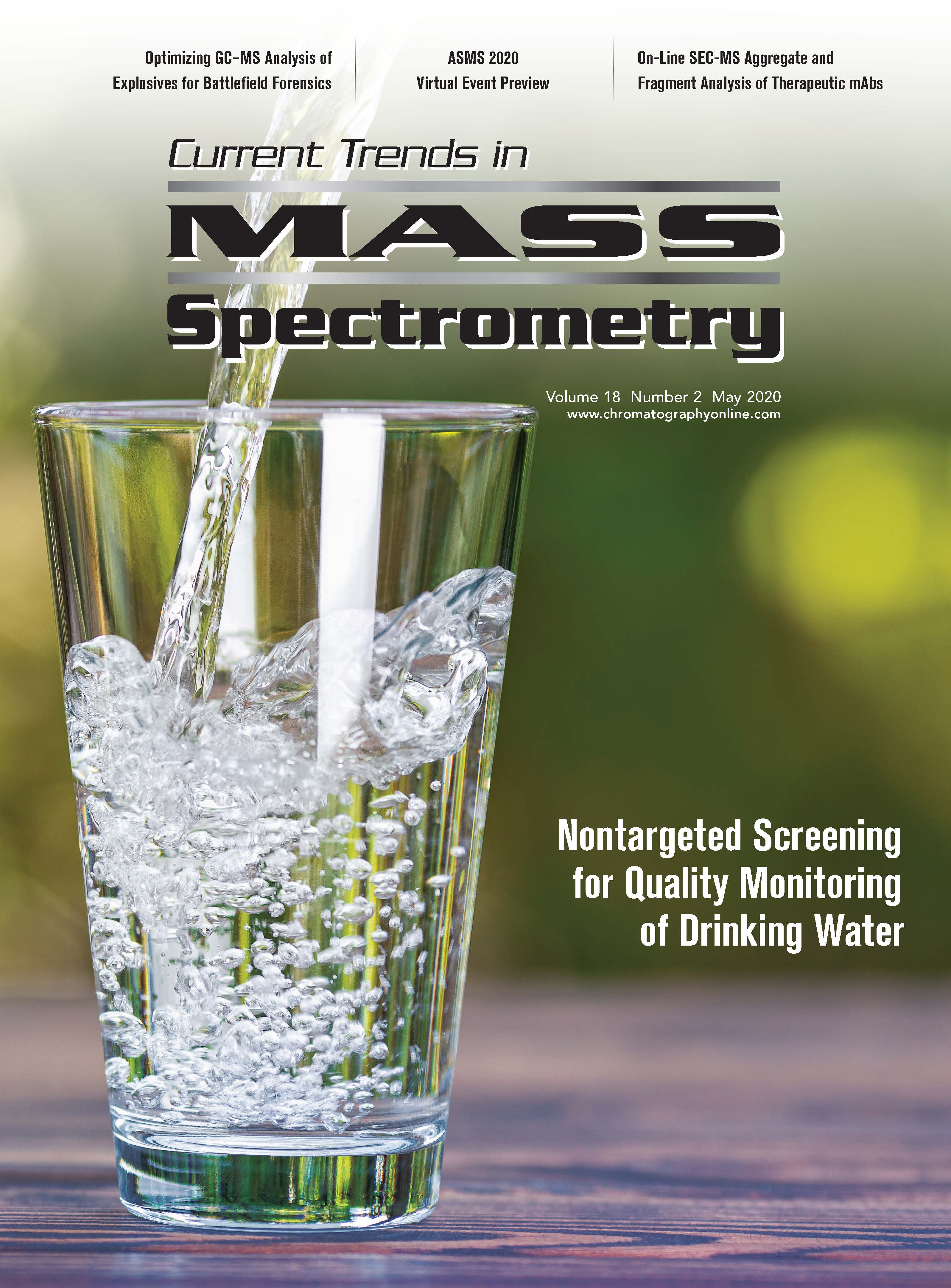
Mass Spectrometry for Forensic Analysis: An Interview with Glen Jackson
November 27th 2024As part of “The Future of Forensic Analysis” content series, Spectroscopy sat down with Glen P. Jackson of West Virginia University to talk about the historical development of mass spectrometry in forensic analysis.
Detecting Cancer Biomarkers in Canines: An Interview with Landulfo Silveira Jr.
November 5th 2024Spectroscopy sat down with Landulfo Silveira Jr. of Universidade Anhembi Morumbi-UAM and Center for Innovation, Technology and Education-CITÉ (São Paulo, Brazil) to talk about his team’s latest research using Raman spectroscopy to detect biomarkers of cancer in canine sera.